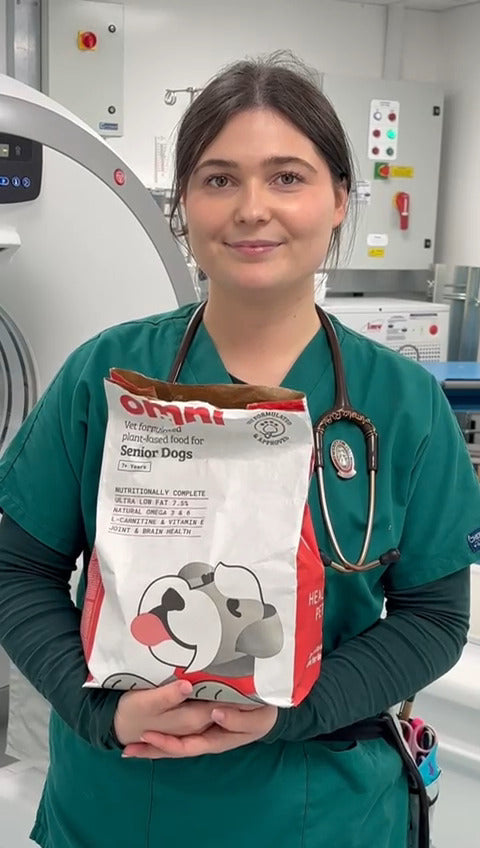Vegan diet more digestible than premium meat-based alternative

The digestibility of Omni’s adult dog food was higher for protein, vitamins and minerals compared to various meat-based alternatives.
During a very recent study, Omni Adult food was fed to 10 dogs of mixed ages (2-15yo), breeds, and sexes over a period of ten days, as their full ration. Faeces of the dogs were collected for 5 days, in accordance with the FEDIAF (European Pet Food Industry Federation) protocol, and then analysed for a variety of digestibility parameters. The food itself was also analysed to assist with digestibility comparisons. The same cohort of dogs were previously fed three other foods and had the same parameters analysed. The three other foods included a standard meat-based diet, a premium standard meat-based diet, and a premium quality meat-based diet.
Dogs eat more Omni
Dogs chose to eat more Omni than the meat based diets showing a palatability preference for the vegan option.
Total food consumed per day per dog was assessed. The dogs consumed more Omni Adult food over the study period compared to the other study periods for the other 3 meat-based foods. In some cases the dogs ate almost 10% more of Omni than the meat-based diets. These findings are consistent with a previous published study that assessed observed palatability of Omni (1).
Omni digestibility outperforms premium meat based dog foods
Dogs eating Omni got more protein from their diet and less fat compared to the meat based alternatives. This could help to reduce obesity and related health problems whilst maintaining athletic body conditions in dogs.
Overall, when compared to the other diets, Omni Adult food contained the highest level of digestible protein and the least fat. Additionally, digestible protein was 8% higher in Omni Adult than the lowest performing meat-based diet. Similarly, when crude ash (a measure of mineral content) was analysed, Omni had the highest vitamin and mineral bioavailability compared to the premium quality animal-based diet.
Stool consistency was on par with dogs eating the meat based diet.
When stool score (a measure of stool quality) was measured, Omni performed in equivalence to both the standard and premium standard meat-based diets. These findings are also consistent with a previous published study that assessed observed stool quality of dogs fed on Omni (1).
Urine PH
Dogs eating Omni had a slight acidification of their urine - This is positive given the previous reports that vegan diets can predispose dogs to developing alkaline urine, a common precursor to urinary stones and infections.
Urine pH was measured in a smaller subset of the dogs and decreased on average by 0.5 which may be due to the purposeful inclusion of certain levels of the protein building block, methionine to ensure urine doesn’t become too alkaline.
Limitations
There was a gap in time between the study and analysis of the meat-based diets and the Omni Adult diet which could allow for some variability/changes in the dogs and analysis.
The urine PH of the dogs was initially on the high end prior to swapping to Omni which could explain some reduction, additionally only a selection of the cohort had their urine PH measured.
*Data for this study kept on file
(1) Mike Davies. Reported Health Benefits of a Vegan Dog Food – a Likert Scale-type Survey of 100 Guardians. Archives of Clinical and Biomedical Research 6 (2022): 889-905.







 85 Great Portland Street, 1st Floor, London, W1W 7LT United Kingdom
85 Great Portland Street, 1st Floor, London, W1W 7LT United Kingdom





